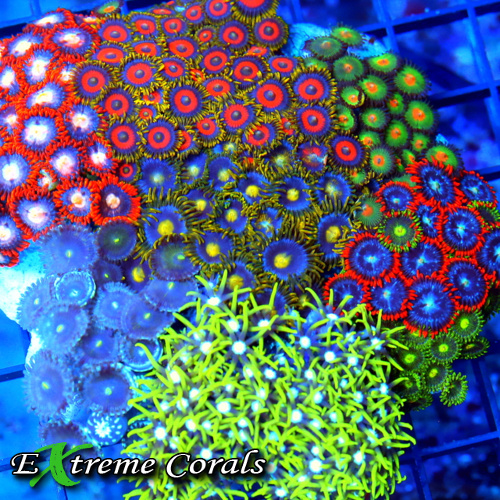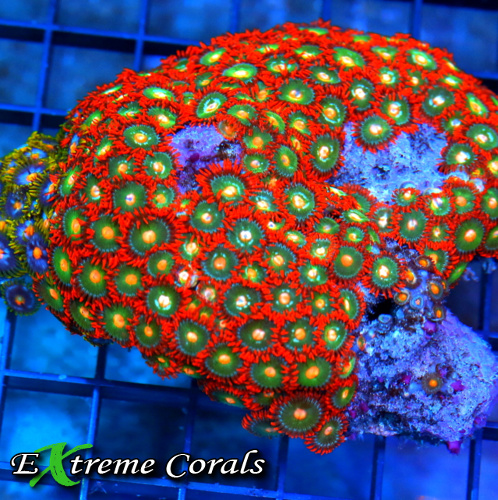Extreme Corals News and Updates
The Fascinating World of Zoanthid Reproduction: How to Grow Your Own Coral Garden
Unlock the Secrets to Thriving Zoanthid Colonies in Your Reef Tank
Discover how to care for, propagate, and create a coral garden with zoanthids. Learn tips for maintaining healthy and colorful zoanthid colonies.
by scott Shiles • August 09, 2024
Exploring the Colorful Realm of Zoanthids
Welcome to the mesmerizing world of zoanthids! These stunning coral creatures are like living jewels adorning the ocean floor, showcasing a vibrant array of colors and patterns. Zoanthids, also known as zoas, are a favorite among reef enthusiasts due to their beautiful appearance and relative ease of care. Their diverse color combinations, ranging from electric blues to fiery oranges, create a captivating underwater spectacle that enriches any coral garden.
One of the most fascinating aspects of zoanthids is their ability to reproduce in various ways. By understanding the different methods of zoanthid reproduction, hobbyists can not only expand their coral collections but also contribute to the conservation of these unique marine organisms. Whether through natural spawning events or human-assisted techniques like fragging and propagation, the world of zoanthid reproduction offers a wealth of possibilities for coral enthusiasts to explore.
Imagine witnessing the magical process of zoanthids multiplying within your own aquarium, creating a flourishing ecosystem right before your eyes. The intricate dance of life and growth that takes place in a well-maintained coral garden is a true wonder of nature. From tiny polyps budding to colonies spreading and thriving, each stage of zoanthid reproduction is a testament to the resilience and beauty of these marine gems.
As you delve deeper into the realm of zoanthids, you'll discover the nuances of their reproductive strategies and the delicate balance required to support their proliferation. By learning about the specific needs of different zoanthid species and honing your coral care skills, you can create an ideal environment for these marvelous organisms to flourish. From water quality management to proper lighting and feeding schedules, every aspect of zoanthid husbandry plays a crucial role in their reproductive success.
The vibrant hues and intricate patterns displayed by zoanthids serve as a visual feast for coral enthusiasts, drawing them into a world of endless fascination and discovery. Whether you're a seasoned reef keeper or a novice aquarist, the allure of cultivating a thriving coral garden filled with these mesmerizing creatures is undeniable. By immersing yourself in the captivating world of zoanthid reproduction, you not only expand your knowledge and skills but also gain a deeper appreciation for the wonders of the marine ecosystem.
Understanding Zoanthid Reproduction Methods

Zoanthids exhibit a remarkable ability to propagate and reproduce through various methods, each offering unique insights into the life cycle of these fascinating organisms. One common technique used by hobbyists is fragging, which involves carefully cutting a healthy zoanthid colony into smaller frags that can grow into independent colonies over time. Fragging not only allows aquarists to expand their coral collections but also helps rejuvenate aging colonies and prevent overcrowding in the aquarium.
Propagation is another key method employed in zoanthid reproduction, where coral fragments or polyps are encouraged to multiply and establish new colonies. By providing the right conditions, such as stable water parameters and optimal lighting, aquarists can promote the growth and reproduction of zoanthids in their tanks. This hands-on approach to coral cultivation not only enhances the beauty of the aquarium but also fosters a deeper connection with these marine creatures.
Through careful observation and experimentation, hobbyists can uncover the secrets of successful zoanthid propagation and refine their techniques to achieve sustainable growth. By studying the behavior of zoanthids during different reproductive stages and adapting their husbandry practices accordingly, aquarists can create a thriving coral ecosystem teeming with life and color. The satisfaction of watching newly propagated zoanthids flourish and form robust colonies is a rewarding experience that highlights the magic of coral cultivation.
As you explore the diverse methods of zoanthid reproduction, you'll come to appreciate the intricacies of coral biology and the interconnectedness of marine life within the aquarium environment. By honing your skills in fragging, propagation, and coral care, you not only enhance the aesthetic appeal of your tank but also contribute to the conservation of these delicate organisms. Each successful propagation represents a small victory in the effort to preserve and safeguard the beauty of zoanthids for future generations to enjoy.
Creating Your Ideal Coral Garden Habitat

Building the perfect habitat for your zoanthid garden requires careful planning, attention to detail, and a deep understanding of coral requirements. From selecting the right tank size and layout to establishing a stable environment with proper water circulation and filtration, every aspect of aquarium setup plays a crucial role in the success of your coral garden. By creating a harmonious balance of elements, such as live rock formations, substrate types, and coral placements, you can design a captivating underwater landscape that nurtures and sustains your zoanthid colonies.
Lighting is a key factor in zoanthid care, as these photosynthetic organisms rely on adequate light sources to thrive and grow. By choosing the right type of lighting system and adjusting the intensity and spectrum to mimic natural conditions, you can create an optimal lighting environment for your zoanthids. Proper lighting not only enhances the coloration and growth of your coral garden but also supports vital photosynthetic processes that are essential for the health and vitality of zoanthid colonies.
Water quality maintenance is paramount in ensuring the well-being of your zoanthids and promoting successful reproduction in your aquarium. Regular water testing, proper nutrient supplementation, and diligent maintenance routines are essential to keep the parameters within optimal ranges for coral growth. By monitoring and adjusting factors like temperature, salinity, and nutrient levels, you can provide a stable and nurturing environment that encourages the proliferation of zoanthids and other coral species in your tank.
Essential Tips for Successful Zoanthid Cultivation

To cultivate healthy and vibrant zoanthid colonies, aquarists must pay attention to key factors that contribute to their well-being and reproductive success. Maintaining stable water parameters, including temperature, salinity, and pH levels, is essential for the overall health of zoanthids and other coral inhabitants. Regular water changes, proper dosing of supplements, and effective filtration systems are crucial in keeping the aquarium environment pristine and conducive to coral growth.
Feeding zoanthids with specialized coral foods or zooplankton supplements can help enhance their coloration and promote robust growth. By providing a varied diet rich in essential nutrients and trace elements, aquarists can support the nutritional needs of zoanthids and promote their reproductive capabilities. Observation of feeding behaviors and adjusting feeding schedules based on coral response are key aspects of successful zoanthid cultivation that can lead to thriving and flourishing colonies in your aquarium.
Regular maintenance and observation of zoanthid colonies are vital for detecting any signs of stress, disease, or pests that may impact their health and reproduction. By conducting routine inspections, fragging overgrown colonies, and addressing any issues promptly, aquarists can safeguard their zoanthid populations and maintain a healthy balance within the coral garden. Additionally, staying informed about best practices in coral husbandry and seeking advice from fellow hobbyists and experts can provide valuable insights for successful zoanthid cultivation.

